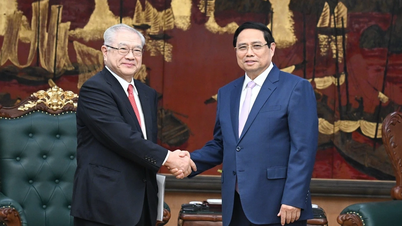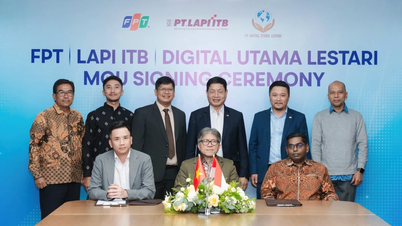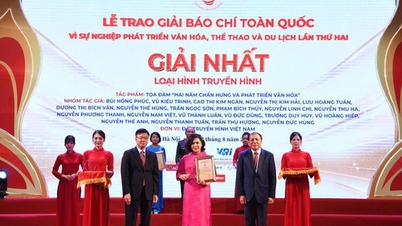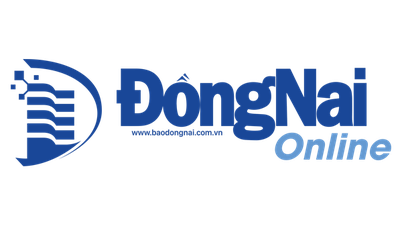
FPT 's exhibition booth on AI applications in various fields.
Today, from creating visual, audio, text content to automated decision support, many AI products are unlabeled and shared as regular content. The consequence is that users do not know whether they are interacting with human- or AI-generated content and may believe in misinformation or manipulation.
For example, a beauty salon posts an AI-generated advertisement with a model image, making customers mistakenly believe it is real, but when they experience the service, they discover that the quality is not as advertised. More dangerous is that AI creates fake photos of famous people, videos simulating the statements of politicians, or articles created by AI but with the names of real people, damaging personal honor and the reputation of agencies and organizations.
In addition, the lack of a labeling mechanism reduces users' trust in digital platforms and AI products. A digital environment that is not transparent about the origin of content will make users suspicious and distant. Meanwhile, most Vietnamese users do not have the habit of identifying and verifying the origin of content, and technical tools to detect AI products are limited.
Clearly defining transparency and labeling obligations is not only a technological ethical requirement, but also a legal basis to protect both users and developers of AI products. To meet this requirement, the Ministry of Science and Technology is developing the Law on Artificial Intelligence, with Article 12 stipulating “Transparency, labeling and accountability”.
Accordingly, labeling is the application of technical measures to clearly, easily recognizable and machine-readable notice that content (text, image, audio, video) was created or significantly modified by AI systems. The notice must be made when the content is widely published.
This regulation establishes mandatory labeling obligations for products created or edited by AI, aiming to make the digital space transparent, protect consumers, and require suppliers and deployers to be jointly responsible if the failure to label causes confusion or damage.
For content simulating real people, objects, places or events, the Draft Law stipulates that providers must apply measures to clearly identify that the content is created by AI and ensure the ability to authenticate and trace its origin. This is considered an important step in managing AI technology, in line with international trends when the European Union (EU), the United States, Japan and South Korea have all issued similar regulations.
Despite agreeing on the necessity, many experts and businesses believe that the labeling regulations in the Draft Law need to be more specific. Lawyer Hoang Le Quan, Vietnam Commercial Legal Limited Liability Law Firm (Lexcomm Vietnam LLC), believes that it is necessary to clarify whether AI providers can decide on the form of labeling themselves or must follow the Government's instructions.
If there are guidelines, they need to be clear and ensure harmony with international standards, avoiding Vietnam's requirements being completely different or creating new obligations, especially for multinational suppliers, affecting Vietnam's competitiveness in AI application and development compared to other markets such as the European Union (EU), South Korea or the United States.
Some opinions emphasize the need to clearly define the scope and level of application, whether all content with AI elements must be labeled, or only products created entirely by AI or significantly intervened. Mr. Tran Van Tri, Director of Vietnam Law Media Joint Stock Company (LuatVietnam.vn) said that when the content only has a small part applying AI, is it necessary to label it or not? It is necessary to clearly state whether AI assisted creation or AI completely created.
In the entertainment industry, some companies want a flexible mechanism to exempt AI products from rigid labeling obligations, and instead apply warnings or transparent self-disclosure depending on the level of use. AI is widely used to improve sound, images, and effects. If all were required to be labeled, costs and procedures would increase, hindering creativity.
The leader of the Ministry of Science and Technology said that the Draft Law on Artificial Intelligence is built in the direction of finding a reasonable balance between management and development encouragement, ensuring transparency, feasibility and approaching international standards. The goal of labeling is to clarify the boundary between human-created content and machine-generated content, avoiding both extremes of lax management or excessive tightening, so that technology can be developed within a transparent and responsible framework.
HA LINH
Source: https://nhandan.vn/minh-bach-hoa-san-pham-tri-tue-nhan-tao-post920112.html


![[Photo] Fall Fair 2025 and impressive records](https://vphoto.vietnam.vn/thumb/1200x675/vietnam/resource/IMAGE/2025/11/03/1762180761230_ndo_br_tk-hcmt-15-jpg.webp)

![[Photo] Lam Dong: Close-up of illegal lake with broken wall](https://vphoto.vietnam.vn/thumb/1200x675/vietnam/resource/IMAGE/2025/11/03/1762166057849_a5018a8dcbd5478b1ec4-jpg.webp)

![[Photo] General Secretary To Lam receives Singaporean Ambassador Jaya Ratnam](https://vphoto.vietnam.vn/thumb/1200x675/vietnam/resource/IMAGE/2025/11/03/1762171461424_a1-bnd-5309-9100-jpg.webp)
![[Photo] Prime Minister Pham Minh Chinh receives the Chairman of the Japan-Vietnam Friendship Association in the Kansai region](https://vphoto.vietnam.vn/thumb/1200x675/vietnam/resource/IMAGE/2025/11/03/1762176259003_ndo_br_dsc-9224-jpg.webp)














![[Photo] Fall Fair 2025 and impressive records](https://vphoto.vietnam.vn/thumb/402x226/vietnam/resource/IMAGE/2025/11/03/1762180761230_ndo_br_tk-hcmt-15-jpg.webp)
![[Video] Digital transformation and artificial intelligence: the breakthrough development platform of modern medicine](https://vphoto.vietnam.vn/thumb/402x226/vietnam/resource/IMAGE/2025/11/03/1762180464388_hoi-nghi-khoa-hoc-benh-vien-bach-mai-8223-jpg.webp)


![[Photo] Prime Minister Pham Minh Chinh receives the Chairman of the Japan-Vietnam Friendship Association in the Kansai region](https://vphoto.vietnam.vn/thumb/402x226/vietnam/resource/IMAGE/2025/11/03/1762176259003_ndo_br_dsc-9224-jpg.webp)














































































Comment (0)